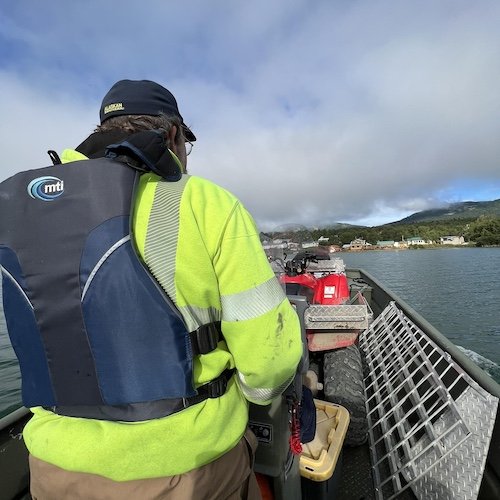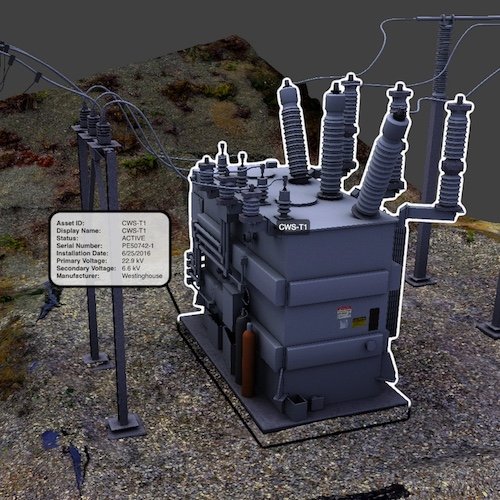Why We Need an Innovation Ecosystem in Alaska
Two startups, two innovation groups, two students, a research group, and an energy utility...
February 27, 2023
6 minute read
View of Kotzebue from the north, in the Kartorium cloud platform
I want to highlight a multi-layered collaboration that I think is best explained in story form. It’s a story I’m proud to have been a small part of, a story of collaboration and innovation that I hope will serve as a wonderful example of how things could be and should be done.
Kotzebue Electric Association (KEA) is a non-profit, electric cooperative with approximately 875 members in Kotzebue, Alaska. Kotzebue is the largest of 11 communities in Northwest Alaska, where there are no roads or transmission lines, and fuel is delivered annually by barge during the summer months. While electricity in Alaska’s villages often costs more than four times the national average, KEA has brought costs down to only twice the national average through the use of wind and solar energy and by initiating energy efficiency programs. The work described below was all in an effort to support KEA’s data needs and to help the community achieve their energy goals.
I met Alora Greer in early spring of 2022. As a Computer Science student at UAA, she had applied to participate in the Students2Startups (S2S) program at the Center for Innovation, Commercialization, and Entrepreneurship (Center ICE) at UAF. We were participating in the program for the second year in a row, as a startup where students might be embedded to gain valuable experience. Alora became one of two S2S interns who joined Kartorium that summer, one of eight Kartorium interns in 2022. More on Alora later.
Meanwhile, a much anticipated project was kicking off. For context, Kartorium participated in Launch Alaska’s Tech Deployment Track in fall of 2021 into spring of 2022. The program was hugely beneficial to Kartorium, resulting in nearly 100 quality leads and an invitation into Launch Alaska’s portfolio. As a portfolio company, Launch Alaska involved us in their Vulnerability Assessment project for KEA, funded by the State of Alaska's Division of Homeland Security and Emergency Management. The idea of the project, in support of Launch Alaska’s mission to accelerate the energy transition, was to inventory and map KEA’s system and create a report identifying potential vulnerabilities to natural disasters and severe weather, and recommending future projects to address them.
With Launch Alaska leading the coordination, 60Hertz would enable the inventory with their Computerized Maintenance Management System (CMMS), Kartorium would handle the mapping, and the three organizations would need to work together to ensure the results were buttoned up into a single deliverable. In this case, that deliverable was the entire KEA power system, navigable in the browser using Kartorium’s digital twin cloud platform, with the 60Hertz images and asset information layered on top and made accessible.
The inventory was carried out by Matt Nejati, Launch Alaska’s Energy Lead, while Kartorium’s own Joseph Byam completed the majority of the 3D mapping in July of 2022. Matt Bergan and his team at KEA were wonderful hosts, even providing vehicles and a place to stay while in town. The inventory data was compiled in 60Hertz and integrated into Kartorium. But there was a problem…
60Hertz's phone app was used to record the GPS locations of the vast majority of KEA’s poles. However, due to the poor cellular connectivity, the locations were recorded haphazardly and inaccurately, resulting in effectively unusable power pole location data.
Matt Nejati and Jay Byam at the KEA wind farm
This is where the Alaska Center for Energy and Power (ACEP) enters the story. ACEP had long been working with KEA and Kotzebue as part of their research developing energy systems for islanded, non-integrated electric grids. Somewhat serendipitously, ACEP personnel were in Kotzebue at the same time we were, and I ran into Dayne Broderson at the Kotzebue airport. I recognized Dayne from my days as a student programmer at Resource Computing Systems under the Geophysical Institute at UAF, where he served as interim director for a time. I learned that he was now at ACEP and that they had also done a recent inventory of (you guessed it) KEA power poles!
The obvious opportunity was before us: combine the 60Hertz and ACEP datasets to deliver KEA the best of both. But nothing is ever that simple, right? I’m here to tell you that this time, because of the good will of all involved, it actually was that simple.
Here’s how:
Vanessa Raymond, Data Governance Lead at ACEP and mastermind of this collaboration, had the idea for ACEP to fund an S2S intern to work with Kartorium and consolidate the datasets. ACEP allowed us to hand-pick the intern, so we selected Alora to continue on with us after S2S ended. In fact, Vanessa knew of S2S through her role as founder of Telesomm, had met Alora through that program, and acted as Alora’s mentor throughout her work with ACEP.
All organizations involved - ACEP, Launch Alaska, 60Hertz, and Kartorium - gave full data rights to KEA for imagery and information collected throughout the various research efforts and the Vulnerability Assessment, a decision becoming more and more rare in today’s information economy. Because of this, we needed only the permission of KEA to proceed, which they graciously granted.
Matt Nejati, Jay Byam, Joseph Byam, and Matt Bergan at the KEA renewables farm
60Hertz gave Kartorium access to their API at no additional cost, and Alora was able to bulk export the asset dataset. ACEP provided their power pole GIS dataset gathered and curated by Lindy Guernsey - an ACEP student employee and UAF engineering student. Lindy also acted as an expert consultant to Alora as she worked through the GIS datasets. Alora then combined the datasets by reviewing the 3D models and drone imagery housed in Kartorium to 1) identify true, precise locations for every pole in the 60Hertz dataset, 2) identify which poles were represented in both datasets to create an association between them, and 3) identify new power poles which were represented in neither dataset. Alora then bulk pushed the improved location data to the 60Hertz database, again only possible because of the API access granted to Kartorium. All of this Alora did without ever traveling to Kotzebue.
I love this story because it’s a wonderful combination of innovative technology and selfless collaboration between well-intentioned parties: two startups, two innovation groups, two students, a research group, and an energy utility. Vanessa put it much better than I could: “I think it tells a very beautiful story about how we need an ecosystem to support this type of work - no one organization can do it alone, and this is a long-form, multi-phase activity that needs sustained effort of all partners in order to be repeatable.” Communities like Kotzebue benefit, students like Alora and Lindy benefit, we all benefit from this kind of work.
Keep it up, everyone.
Related articles
The impact of collaborative data capture and data sharing on community infrastructure
Harnessing technology to empower a cooperative and its people
3D vs. 2D, Interactive vs. Passive, co-starring Signaling and Segmentation






